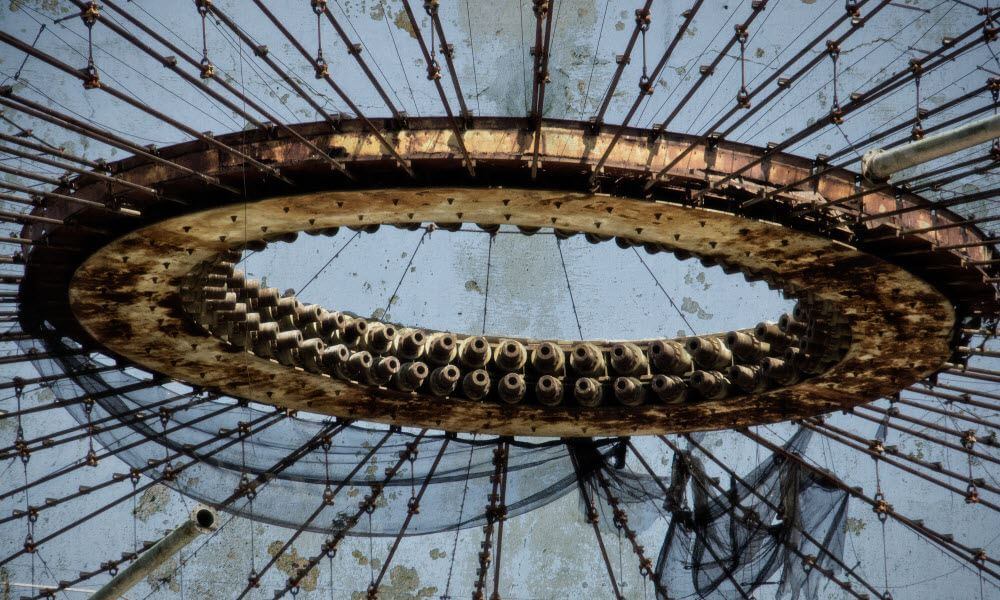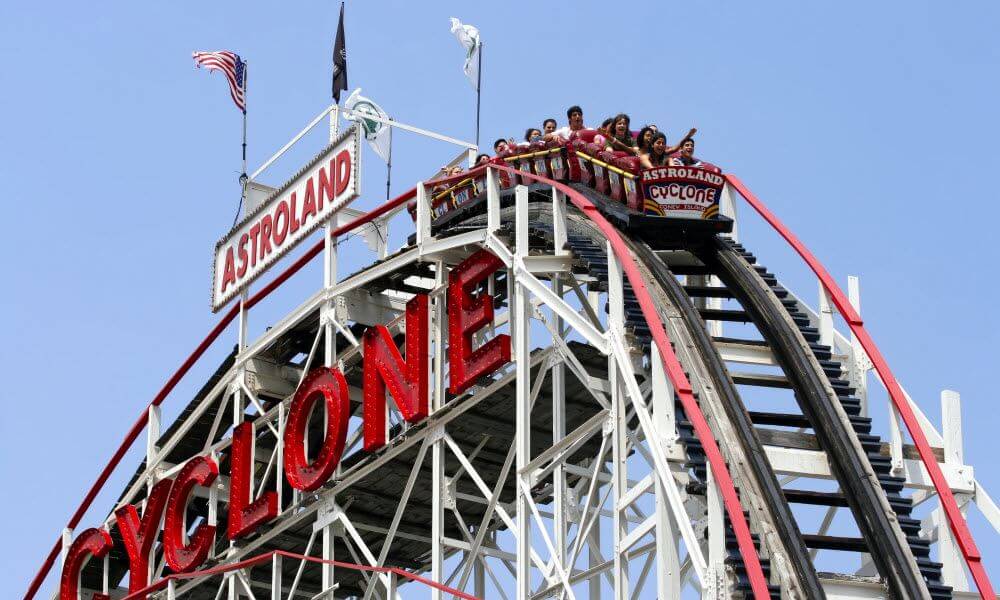Historical landmarks are culturally significant places with a rich background that prompt a sense of wonder and nostalgia to those who visit them. Officially recognized by a government or respected organization, they may exemplify the culture, traditions, entertainment, or work ethic of previous generations. Unfortunately, once past their prime and lacking proper care, these landmarks often fall into disrepair, becoming unsuitable for use and inaccessible to the public. Located outdoors, they are exposed to weather and atmospheric conditions where corrosion quickly takes a toll on the structures. Beyond their historical and aesthetic value, this article examines two landmarks that were deemed worth saving as examples of exemplary design and construction.
The Tent of Tomorrow
The Tent of Tomorrow is an iconic structure that was built at the New York State Pavilion in Flushing Meadows – Corona Park, Queens, New York, for the 1964 World’s Fair. The elliptical-shaped Tent of Tomorrow is a steel structure with sixteen 100-foot (30.5 meter) reinforced concrete piers that support a suspension roof.
Other than serving as a set for an occasional movie or TV show, the site was largely abandoned after the World’s Fair. The public was allowed to visit the site for three hours in 2014 to commemorate the 50th anniversary, but the site was in such a state of disrepair that the attendees were required to wear hardhats due to safety concerns from falling debris.
Scope of Work for the Tent of Tomorrow
Sitting alongside two busy highways and visible to flights operating from New York’s LaGuardia airport, the Tent of Tomorrow was designated for restoration by local residents, the city council, a local painters union, and the New York Structural Steel Painting Constructors Association. The restoration included repainting the structure in its original “American Cheese Yellow” color. The scope involved two phases: surface preparation and coating.

Prior to coating, the landmark’s steel surfaces were solvent-cleaned according to the Society for Protective Coatings SSPC-SP 1 standard, which is a guideline for removing all visible soluble contaminants (e.g., dirt, oil, grease) from the steel surfaces. This method was then followed by removal of all loose paint, rust, foreign matter and mill scale per SSPC-SP 2, and SSPC-SP 3 which cover hand tool cleaning and power tool cleaning, respectively.
Two coats of more than 1,000 gallons (3,785 liters) each, consisting of a primer coat and a top coat were applied to the Tent of Tomorrow,.
A two-component, high solids epoxy coating was selected for the primer coat. This product was selected for its high performance and surface tolerance, allowing for good adhesion on any existing coating that still remained after the aforementioned surface preparation.
Looking for a semi-gloss top coat that provided unlimited recoatability, excellent weather resistance and color retention, the restoration project chose a semi-gloss aliphatic polyurethane top coat specially tinted to meet the project team’s desire to match the original “American Cheese Yellow” color.
In addition to performance requirements such as corrosion resistance and resistance to color fade, limiting emissions from volatile organic compounds (VOC) was also a prerequisite. VOC emissions from coatings have the potential to contribute to ozone levels. Ozone is a major component of smog which has been found to cause negative health and environmental impacts when present in high concentrations at ground level. The high solids products used for the Tent of Tomorrow have low VOCs, thus minimizing the impact on air quality.
The Tent of Tomorrow Restored to Its Original Sunny Luster

The restoration of this longtime eyesore and potential public hazard was successfully completed in August 2015, becoming a source of pride for the community. In recognition of the outstanding achievement, in 2016 the coating manufacturer and the painting contractors were awarded a SSPC Coatings Industry Spirit Award, for a project that benefits a community or industry. A competition was announced in March 2016 to allow the public to provide suggestions for re-imagined possibilities for the pavilion’s future.
The Cyclone Roller Coaster

Coney Island, a neighborhood district and popular entertainment destination in Brooklyn, New York, is home to several amusement parks and three rides designated as landmarks in the National Register of Historic Places. One of these landmarks is the Cyclone, which is America’s oldest wooden roller coaster still in operation.
Built in 1927 and featuring an 85-foot (26 meter) drop and a top speed of 60 miles per hour (96 kilometers per hour), it is constructed primarily of wood (with some iron braces and gussets) in the center section, and structural steel on the ends where the coaster makes some 180-degree turns. The steel structure consists of numerous complex shapes that are bolted and welded together.
Scope of Work for the Cyclone’s Wooden Structure
Located near a beach on the Atlantic Ocean, the Cyclone is continuously exposed to the weather and the corrosive effects of the salt air. Having hosted millions of visitors, and wishing to keep the coaster in operation for future generations, the owners wanted to refurbish the ride by repainting the coaster and replacing corroded steel parts where necessary.
Restoration work began with surface preparation of the wooden members, which were pressure washed with a minimum of 2,000 pounds per square inch (psi) to clean the surface and remove loosely adhered coatings. After cleaning, the wood was allowed to dry below 12% moisture before any coatings were applied. Meanwhile, all wood slivers and the terminal edges of adherent existing coatings were hand sanded. Any new treated lumber was allowed to weather for at least six months and dry below 12% moisture.

An interior/exterior acrylic primer was selected for the base coat, based upon its suitability as a primer for exterior wood (among other materials) and its special formulation that blocks most stains such as water, ink and tannin. The primer was applied with a brush and roller at 1-2 mils dry film thickness over the entire surface.
Following the base coat, a waterbased high-gloss 100% acrylic enamel was applied to the wooden members. This coating proved to be easy to apply, and with excellent gloss retention and resistance to repeated washing, it will maintain the coaster’s pure white appearance for years to come.
Scope of Work for the Cyclone’s Steel Members
The roller coaster body consists of steel members, which were prepared by water-jetting to a minimum SSPC WJ-4 (L) condition
Coating the steel members was accomplished in four steps.
First, crevices were spot sealed with a two-component penetrating epoxy. This primer/sealer is well suited for highly corrosive marine inland/offshore locations and has a wicking action that penetrates and seals rusted steel surfaces.
This was followed by one full coat of a novel one-component, multi-purpose epoxy primer applied at 3-5 mils dry film thickness. This one-component epoxy primer is a true epoxy-amine reactive coating with performance equivalent to that of two-component epoxy coatings, yet eliminating pot life limitations and mixing errors.
An stripe coat of the primer was then applied to the edges of the steel members for added protection. Stripe coating is a very important step in the application of a coating system. Due to surface tension and film shrinkage, liquid coatings have a tendency to flow away from sharp edges, reducing the film thickness on the edges which leads to premature corrosion. Stripe coating compensates for this by adding additional film thickness on the edges.
Finally, the steel received a high-solids, single pack acrylic polysiloxane high gloss top coat. The polysiloxane top coat performs well in marine environments and retains its classic glossy white appearance.
Because of proximity to homes and businesses, all coatings were applied by brush and roller to eliminate the possibility of overspray from spray application drifting long distances and settling on cars and buildings.
The Coney Island Cyclone Restored to Crowd-pleasing Standards
After 90 years, the Cyclone continues to race around the track and delight families and roller coaster enthusiasts. In 2016 the coating manufacturer received two SSPC awards: the George Campbell Award, which honors difficult or complex industrial or commercial coating projects, and the William Johnson Award, for outstanding achievement demonstrating aesthetic merit.
Conclusion
Proper surface preparation and quality coatings are desirable for any coating project. Their importance is magnified when restoring cultural landmarks that have been neglected for years or are located in corrosive environments. With selection of proper modern coatings, historically significant structures that once seemed difficult to maintain or economically unfeasible can be given a second chance to inspire and bring joy to future generations.